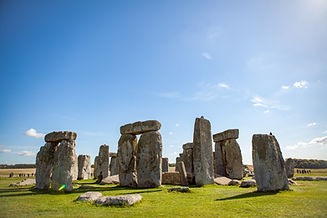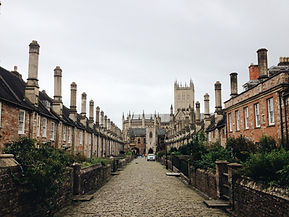LONG HAZEL PARK
Adult Only Touring Caravan Park & Camping
Self-catering Holiday Lodge Accommodation For hire
Sparkford Somerset
VISIT KING ARTHUR'S CAMELOT CASTLE AT SOUTH CADBURY, SOMERSET
Visit us in Somerset and experience the legend of King Arthur and his stronghold of Camelot. The hillfort at South Cadbury has been recorded as King Arthur's Camelot as early as the 1500s in documentation created by John Leland whilst creating the Leland Trail for King Henry VIII.
Legend has it that, during Leland's research, he was informed by many locals of King Arthur, with stories passed down through the years. Further suggestions that Glastonbury is the Isle of Avalon and King Arthur's final battle took place in Queen Camel help support the stories.
VisitEngland awarded Long Hazel Park historical status due to our proximity to King Arthur's Camelot. At just two miles from the hillfort, it makes a fantastic walk from the park, or there is a car park in South Cadbury village.
Take the advice of Caravan Magazine, who recommend a visit to King Arthur's Camelot during your stay. Their article highlighting their favourite "child-free super sites" also gives some great ideas for walking routes whilst on holiday with us in Somerset. We've been picked as one of Premier Parks' Top 100 UK Parks for 2025.

Although competition for King Arthur's Camelot, kingdom and burial ground has been fierce, there is very strong historical evidence, confirmed by modern-day specialists, that South Cadbury is the likely home of Arthur Pendragon and his Knights of the Round Table. The hillfort itself has shown occupation since the Neolithic times, followed by late Bronze Age, with excavations taking place in the 19th and 20th Century, as well as the 1960s and again in 1992. The excavations have shown various buildings of round and rectangular foundations, metalwork, a "Great Hall" and small temples or shrines.
It is thought that Bronze and Iron Age hillforts appeared across Britain for military use and to help defend England from European invasion. Notably, a large shield has been found at the hillfort in the style of northwestern European workmanship from the Bronze Age and you can see this in the Museum of Somerset in Taunton. There are signs of many violent battles in excavations of the area.
The "Great Hall" discovered on site is thought to be in use from 470 - 580 BC, in keeping with the time of King Arthur's battles. The Great Hall is suggested to be 10 m by 20 m and is double the size of any known fort from the period. This would likely have been the room containing the famous Round Table due to its heavy fortification.
The hillfort itself is built on limestone and blue lias, with the summit reaching 500 ft above sea level, the same height as Glastonbury Tor.
In 1542, Leland writes "At the very south ende of the chirch of South-Cadbyri standeth Camallate, sumtyme a famose toun or castelle, apon a very torre or hille, wunderfully enstregnthenid of nature..... The people can telle nothing ther but that they have hard say that Arture much resortid to Camalat."
A number of ghostly sightings have been reported at Cadbury Camelot, including King Arthur's knights, who run along the hunting trail to Glastonbury on moonlit nights. Further mystery surrounds Midsummer's Eve, where it is said that, if you leave a silver coin at the bottom of the hillfort, you will find your horse re-shod in the morning. Another legend says that the hillfort turns as clear as glass at Midsummer, with King Arthur and his knights visible in the ruins.

MERLIN AND THE GLEAM
Lord Tennyson, Poet Laureate during Queen Victoria's reign, wrote of Arthurian legend in twelve poems. Published in 1859, "Idylls of the King" tell the story of the King Arthur, his love for Guinevere and the rise and fall of the kingdom.
Merlin is often featured as King Arthur's advisor, a wizard and mentor, who is able to foretell the future. In Merlin and the Gleam, Tennyson tells of "a love that transcends time and death and links kindred souls through all eternity" whilst it travels through the landscape of Avalon and beyond.
"Clouds and darkness Closed upon Camelot; Arthur had vanish’d I knew not whither, The king who loved me, And cannot die; For out of the darkness Silent and slowly... Hovers the Gleam"
ENGLAND'S PLEASANT PASTURES
"And did those feet in ancient time, walk upon England's mountains green?"
Written by William Blake as part of his poem "Milton", it is thought that the hymn Jerusalem refers to Joseph of Arimathea's visit to Glastonbury, the Isle of Avalon.
Most famously, Joseph of Arimathea was said to have visited Glastonbury with the Holy Grail, containing a few drops of blood from the crucifixion of Christ and turning the water red. Whilst exploring England's pleasant pastures of Glastonbury, Joseph of Arimathea was said to have planted his staff overnight, which grew in to The Holy Thorn, which can be seen at Glastonbury Abbey.


THE BATTLE OF CAMLANN
In 583 BC, King Arthur was killed at The Battle of Camlann, fought between Arthur and his traitorous nephew Mordred. Due to the proximity to Camelot at South Cadbury, Queen Camel is thought to be the most likely site of the battle.
Queen Camel is just under a mile away from us at Long Hazel, where the River Cam flows through the village beneath Camel Hill and Annis Hill. King Arthur's body was then moved from the battleground to the healing Isle of Avalon in the hope that he could be saved. Some texts suggest that the healing waters and magical land could one day bring Arthur back to life.
CADBURY HILLFORT TO GLASTONBURY ABBEY
King Arthur's last journey in Somerset is thought to be from Cadbury Camelot at South Cadbury, to his final resting place at Glastonbury Abbey. The bodies of King Arthur and his Queen, Guinevere, were found by monks at Glastonbury Abbey in 1191, where a hollow log buried in the grounds contained the two bodies with an inscription of their names.
In 1278, King Edward I travelled to Glastonbury to watch as the bodies were re-interred into a black marble tomb. The abbey was partially destroyed under the rule of King Henry VIII, however, enough remnants were left for modern historians to pinpoint the locations of the graves which you can still visit today.
Mapping out a direct route between Camelot and Glastonbury Abbey would have taken the body of King Arthur through Long Hazel Park on its final journey.


THE ISLE OF AVALON
The Isle of Avalon, literally meaning "the island of apple trees" features heavily in Arthurian mythology. Thought to be Glastonbury Tor, which was an island surrounded by marshland, it first appeared in Geoffrey of Monmouth's 1136 "Historia Regum Britanniae", an account of 2000 years of British history.
Avalon is first mentioned in literature as the place where Excalibur, King Arthur's sword, was forged. The Isle of Avalon was said to be controlled by nine sisters and accessed by boat.
DOG WALKS & WALKING HOLIDAYS
One of our favourite local walks is from the park, through Sparkford woods and on to Cadbury Hillfort. The whole walk is around six miles and great for energetic dogs. The hillfort itself is around 18 acres of open field, which is ideal for running around off the lead.
If you're looking for dog walks during your stay, we have lots mapped out of different fitness levels.


ARTEFACTS FOUND IN SPARKFORD
Archaeological digs taking place in Sparkford have found artefacts from over 7000 years ago. Wessex Archeology have discovered a number of intricate items which explain how our ancestors lived in the West Country. The excavation has taken place near to Long Hazel and features items such as copper jewellery; weaving tools worked from bone and Neolithic and Mesolithic flint tools which have been preserved. Previous excavations along our boundary have found Roman pottery remains.
Read the article via the Somerset County Gazette:
OTHER HISTORICAL INTEREST IN SOMERSET
Somerset is full of many fantastic historical sites, both large and small, across the county. With carbon dating presenting findings from as far ago as 8400 BC, there's a whole host of history to see! Let us guide you through time to plan your perfect holiday exploring the county!
MESOLITHIC ERA
CHEDDAR MAN

Britain's oldest human skeleton, Cheddar Man, was found in a cave in Cheddar Gorge. The skeleton dates from 7150 BC and was found to be lactose intolerant, despite living in caves now used to mature Cheddar cheese!
FOSSIL HUNTING

Take a day trip to Dorset and spend a day fossil hunting at Lyme Regis. Monmouth Beach is the best for fossils, where parts of the cliff have eroded and fallen on to the beach to be found!
SOMERSET ISLANDS

With much of the land flooded during the Mesolithic era, Somerset was a series of islands. On the island "Greylake" near Middlezoy, two skulls from an open-air cemetery have been radiocarbon dated to c8,400 BC; 5,600 years older than Stonehenge.
BRONZE AGE
THE SWEET TRACK

The Sweet Track was constructed in the Somerset Levels during 3807-3806 BC. It's known to be one of the oldest roads in the world, dated by the timbers used to construct the track which were preserved in the boggy earth.
CADBURY HILLFORT

Cadbury Hillfort, or King Arthur's Camelot at South Cadbury, is thought to have been built around the turn of the first millennium BC. The origin is unknown, although it is likely to have been built by the military of the era to ensure safety or control.
STONEHENGE

You'll likely have seen Stonehenge on your drive to Somerset, with the famous stone circle constructed between 3000-1599 BC. It's one of UNESCO's World Heritage Sites and can be visited as a National Trust property.
IRON AGE
HAM HILL

Covering 80 hectares of countryside, Ham Hill is Britain’s largest Iron Age hillfort and was occupied from Neolithic until Roman times. Items including a Bronze Age dagger, Roman military items and Glastonbury Ware pottery vessels and human remains have been found here.
GLASTONBURY LAKE VILLAGE

Glastonbury Lake Village, now known as Godney, is the best preserved pre-historic village ever found in the UK. The remains show the first clear evidence of housing of domesticated animals and storage of grain on site
WOOKEY HOLE

Wookey Hole's Great Cave has been excavated to reveal a range of items confirming habitation. Human bones have been found in a deep pit. These bones are presumed to belong to the Witch of Wookey Hole, whose body was thought to turn to stone in the cave.
ROMAN TIMES
THE ROMAN BATHS AT BATH

A wellbeing location since the Roman times, Bath was used for its hot underground springs to create elaborate thermal baths. You can visit both the original Roman Baths and the modern baths for a great day trip to the city.
THE ROMAN VILLA AT THE NEWT

Building on the remains of a Roman villa, local gardens The Newt at Hadspen have unearthed and reimagined a settlement from 351 AD. With AI headsets to help guide you around the villa and gardens, the museum also hosts Somerset artefacts.
THE SOMERSET FLAG

You'll often see the Somerset flag flying around the county: a red dragon on a yellow background. The dragon was said to be worn during a famous jousting match between King Arthur and Lancelot as Knights of the Round Table.
MEDIEVAL SOMERSET
VICARS' CLOSE, WELLS

Visit Europe's oldest residential street, the Vicars' Close, in Wells. The cobbled street features exclusively Medieval houses and is set in Britain's smallest city of Wells.
GLASTONBURY ABBEY

See the graves of King Arthur and Guinevere at Glastonbury Abbey. Originally established on the grounds of the original church founded by Joseph of Arimathea, it later became a Saxon monastery.
GLASTONBURY TOR

Glastonbury Tor, is dedicated to St Michael, the second church on this spot as the first was destroyed by an earthquake. It was built in the 14th century and, as well as a religious site, has also been used historically for hangings.
AVON ARCHAEOLOGY
Visit the new Avon Archaeology centre at Avalon Marshes Visitor Centre, Glastonbury to explore their new reconstructions. You'll find a full sized Saxon longhall building based on the 9th century Saxon Royal Palace at Cheddar; a dining room of a Roman villa with working hypocaust heating and a Viking trading ship. You'll also be able to visit the oldest surviving archaeological excavation hut in the UK, with its own mini cinema which has been used in archaeological digs in Somerset over the 19th and 20th Centuries.


CASTLE CARY
Our nearest town of Castle Cary has fantastic history of its own. Castle Cary housed a castle of its own, first made of timber and later of Cary stone from a local quarry. The castle was left to ruin, but the grounds are still open to the public.
In the 1700s, Castle Cary was one of the principal cloth-making towns of the area, specialising in linen weaving. One such important cloth was horsehair cloth, used for upholstery. The towns' factory still exists and weaves the cloth on late-nineteenth century looms.
Another notable feature of Castle Cary is the town lock-up, known as the Round House. It was built on Bailey Hill, in the centre of the town, in 1779 and is one of only a handful of lockups still remaining in England. The roof of the lockup is said to have been the inspiration for the modern policeman's helmet.
NATIONAL TRUST PROPERTIES
STOURHEAD

Enjoy 2,560 acres of countryside; Iron Age hillforts and one of the first grand Palladian-style villas to be built in England. Stourhead also features King Alfred's Tower, a 160 foot folly offering views of Somerset, Wiltshire and Dorset.
MONTACUTE HOUSE

Built in the 16th century, an Elizabethan manor constructed of local ham stone, Montacute features a rare Elizabethan compartmentalised gardens. It also features the West Country outpost of The National Portrait Gallery collection.
LYTES CARY

An Arts and Crafts inspired garden; a chapel from the 1300s and 350 acres of woodland and estate land to explore. Lytes Cary features a botanical book - "Cruydeboeck" - translated from Flemish and dedicated to Queen Elizabeth 1 in 1578.
THE TUDORS, THE STEWARTS
BURROW MUMP

Burrow Mump, also known as St Michael's Burough of Tuttlegate, is an historic site overlooking Southlake Moor in Burrow Bridge. On top of Burrow Mump is a 15th century church that was never completed. Burrow Mump was associated with King Alfred who "accidentally burnt the cakes".
THE MONARCH'S WAY

The Monarch's Way is the escape route taken by King Charles II following his defeat in the Battle of Worcester in 1651. It is 625 miles long, from Worcester to Sussex, via Castle Cary in Somerset using public rights of way and follows the King's six week run from captivity.
SIEGES OF TAUNTON

During the first English Civil War, Taunton was regarded of high importance as the gateway to the West Country. As such, it came under attack three times during 1644-1645. You can still visit Taunton Castle, which houses the Museum of Somerset.
SOMERSET HISTORICAL EVENTS
Enjoy historical reinactments and events across the county of Somerset and partake in history!
Visit Cadbury Camelot on Midsummer's Eve (24 June) to see the hillfort turn "as clear as glass" and reveal King Arthur and his Knights of the Round Table within.
Glastonbury Abbey holds an annual Medieval fayre with 2023's fayre held from 22 - 23 April. The Medieval fayre features battle reinactments, speakers, fine ale and jousting!
Templecombe hosts a further Medieval Pageant, this year on 3 June 2023. The pageant features displays of medieval fighting, falconry and a reinactment of The Battle of Templecombe!


OUR OWN HISTORY
Long Hazel Park was established as emergency housing just after World War II. The site originally housed old fashioned static caravans, which housed many families still living in the area today.
Prior to the development of the caravan park, Long Hazel Park was part of the village dairy farm. The farm was run as a community collective, with milk taken daily to London from Sparkford train station via steam train.
Before that, Long Hazel Park formed part of the Hazlegrove estate, belonging to the 18th century, Grade II listed manor house nearby. The village was covered in oak trees and we are fortunate to have an old oak on our park, dating from around 400 years ago. Whilst many old oaks were felled to build naval war ships at this time, we believe the oak was allowed to continue to grow as it appears to have been struck by lightening. We have two newer oak trees on site which have been planted from the acorns.







